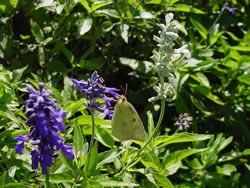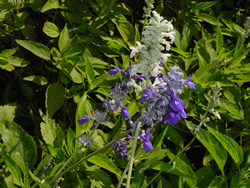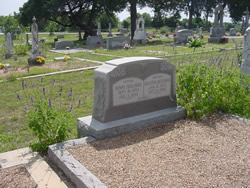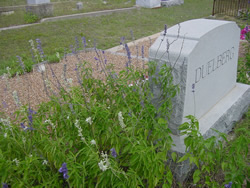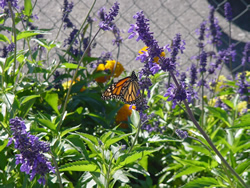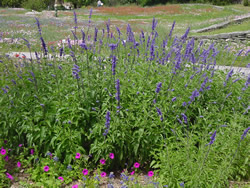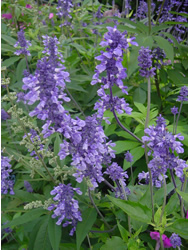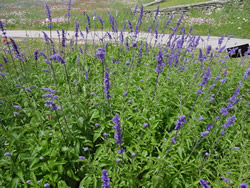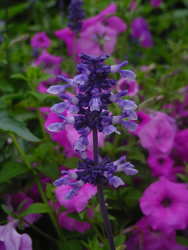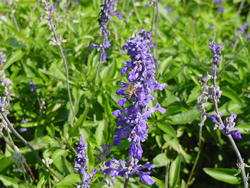
Search
For The Answer
Click here to access our database of
Plant Answers
Search
For The Picture
Click here to access the Google database of plants
and insects
Information
Index
Alphabetical Listing of Topics, Recommendations
and Plants
- Turf Grass & Sod
- Milton Glueck, Host of Milberger's Gardening Show
- Arcadia
Archives -
Greg Grant - Friends of PLANT Answers
Milberger's Nursery and Landscaping
3920 North Loop 1604 E.
San Antonio, TX 78247
210.497.3760
nursery@milbergersa.com
Open 9 to 6 Mon. through Sat.
and 10 to 5 on Sun.

Three exits east of 281, inside of 1604
Next to the Diamond Shamrock station
Please click map for more detailed map and driving directions.
| Salvia, Henry Duelberg
Each year, Texas A&M promotes their Texas Superstar selections for the year. Texas Superstar plants are selected by CEMAP (the Coordinated Educational and Marketing Assistance Program) after several years of successful trialing throughout the state. CEMAP makes a concerted effort to introduce new products to the Texas nursery industry that make gardening easier and more environmentally sound for the gardening masses in the state. One of this year's promotions, the Duelberg sage (Salvia 'Henry Duelberg') happens to be a plant that I found and introduced to the Texas nursery trade. I'm a decent plant breeder but my forte seems to be stumbling across improved plants in unlikely places. For instance, the Gold Star esperanza came from a yard in an impoverished neighborhood in San Antonio. The Marie Daly rose was a sport in my mom's backyard in the Pineywoods of East Texas. And the VIP petunia came from a flower bed in front of a pay toilet in Stuttgart, Germany! I actually prefer to look for plants growing in less than average conditions as it helps insure that the general public can grow them without any special input. Although most gardeners (even the bad ones) generally provide at least the bare minimum of needs for their plants I would prefer to find them growing with NO horticultural help whatsoever. I want to know if they can survive with no water, no fertilizer, no weeding, no grooming, and no pesticides. When I hear a plant touted as needing dividing every three years, or needing periodic fungicide treatments to thrive, I immediately strike them from my list. Sure, we all have the option of installing sprinkler systems, double digging our beds, and spraying insecticides and fungicides every ten days, but I for one "ain't gonna do it". First of all, it doesn't make sense from a health or labor stand point. Plus, after two back surgeries, I'm looking for plants that can do some of their own work for a change. The free ride is over! That's why I prefer looking
in poor neighborhoods, country gardens, and along Texas highways.
These folks aren't known for spoiling and pampering their plants.
But it's always hard to tell. Some folks like to sneak around
at night (especially during hot Texas summers), with a horticultural
IV, reviving all their marginally adapted plants. THAT'S why my
favorite place of all to look for Texas tough plants is in rural
cemeteries (at least those that haven't banned living plants like
some brain dead places have). You KNOW these residents aren't
spoiling their plants (short of a little extra bone meal!). Typical nursery plants are about a foot tall with dark purple-blue flowers. Being dwarf isn't always better though. In most of the bedding plant trials I've planted and evaluated, the dwarf forms of plants are inferior in performance to their larger sized parents. It only makes sense. After all, the reason they are dwarf is that they don't grow! If they actually GREW, they wouldn't be dwarf any more, right? Ever since the Victorian "bedding out" period, breeders think all bedding plants have to be less than a foot tall. This desire actually sprang from the practice of planting floral carpets to be viewed from upper story castle windows. Well guess what? My "castle" has no upper stories! Plants bred to look like blueberry muffins sitting
in the landscape might work fine during a mild, moist Dijon summer
but unfortunately often don't cut the hot mustard here in Tejas.
In order to survive hot Texas summers, which may be desert dry
with periodic interruptions of flash flooding, plants BETTER be
vigorous. Toss in foot traffic, cars, armadillos, grandchildren,
inebriated neighbors, etc. and being dwarf doesn't look like such
a blessing. If our plants aren't growing and constantly repairing
damage, they are often doomed. I would much rather trim an overly
vigorous plant back than to be forced to replace a dead "Miss
Manners". |




